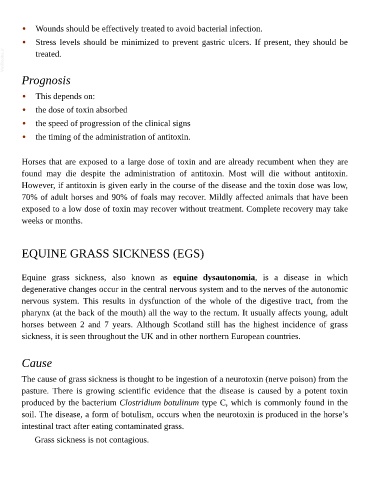Page 505 - The Veterinary Care of the Horse
P. 505
• Wounds should be effectively treated to avoid bacterial infection.
• Stress levels should be minimized to prevent gastric ulcers. If present, they should be
VetBooks.ir treated.
Prognosis
• This depends on:
• the dose of toxin absorbed
• the speed of progression of the clinical signs
• the timing of the administration of antitoxin.
Horses that are exposed to a large dose of toxin and are already recumbent when they are
found may die despite the administration of antitoxin. Most will die without antitoxin.
However, if antitoxin is given early in the course of the disease and the toxin dose was low,
70% of adult horses and 90% of foals may recover. Mildly affected animals that have been
exposed to a low dose of toxin may recover without treatment. Complete recovery may take
weeks or months.
EQUINE GRASS SICKNESS (EGS)
Equine grass sickness, also known as equine dysautonomia, is a disease in which
degenerative changes occur in the central nervous system and to the nerves of the autonomic
nervous system. This results in dysfunction of the whole of the digestive tract, from the
pharynx (at the back of the mouth) all the way to the rectum. It usually affects young, adult
horses between 2 and 7 years. Although Scotland still has the highest incidence of grass
sickness, it is seen throughout the UK and in other northern European countries.
Cause
The cause of grass sickness is thought to be ingestion of a neurotoxin (nerve poison) from the
pasture. There is growing scientific evidence that the disease is caused by a potent toxin
produced by the bacterium Clostridium botulinum type C, which is commonly found in the
soil. The disease, a form of botulism, occurs when the neurotoxin is produced in the horse’s
intestinal tract after eating contaminated grass.
Grass sickness is not contagious.

